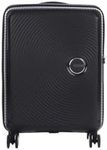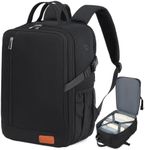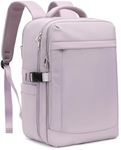Buying Guide for the Best Carry On Bags
Choosing the right carry-on bag is essential for a smooth travel experience. The perfect carry-on should be easy to handle, fit within airline size restrictions, and accommodate your travel essentials. When selecting a carry-on bag, consider factors such as size, weight, material, compartments, and additional features that suit your travel style and needs.SizeSize is crucial because airlines have specific restrictions for carry-on luggage dimensions. Typically, the maximum size is around 22 x 14 x 9 inches, but this can vary by airline. It's important to check the airline's policy before purchasing. If you frequently travel with different airlines, opt for a bag that meets the most restrictive size requirements. Consider your packing habits; if you pack light, a smaller bag might suffice, but if you need more space, ensure it still fits within the limits.
WeightThe weight of the carry-on bag itself can impact how much you can pack without exceeding airline weight limits. Lighter bags allow you to pack more items without going over the limit. Bags typically range from 4 to 10 pounds. If you tend to pack heavy, choose a lighter bag to maximize your packing capacity. Conversely, if you pack minimally, the weight of the bag may be less of a concern.
MaterialThe material of a carry-on bag affects its durability, weight, and appearance. Common materials include hard-shell plastics like polycarbonate, which offer protection for fragile items, and soft fabrics like nylon or polyester, which are lighter and more flexible. If you prioritize durability and protection, a hard-shell bag might be best. For those who value flexibility and lighter weight, a soft-sided bag could be more suitable.
CompartmentsCompartments help organize your belongings and make it easier to access items during travel. Some bags have multiple pockets and dividers, while others have a more open design. If you like to keep your items organized and separate, look for a bag with several compartments. If you prefer a more open space for packing, a bag with fewer compartments might be ideal.
WheelsWheels on a carry-on bag can significantly affect ease of transport. There are two main types: two-wheel and four-wheel (spinner) designs. Two-wheel bags are better for rough terrain and pulling behind you, while four-wheel bags offer more maneuverability and can be pushed alongside you. Consider your travel habits; if you often navigate crowded airports, a four-wheel bag might be more convenient. For those who travel on uneven surfaces, a two-wheel design could be more practical.
HandlesHandles are important for comfort and ease of use. Look for a bag with a sturdy, adjustable telescopic handle that suits your height. Some bags also have side and top handles for easier lifting. If you frequently lift your bag into overhead compartments, additional handles can be beneficial. Ensure the main handle is comfortable to grip and extends to a height that allows you to maneuver the bag without straining.
Security FeaturesSecurity features like lockable zippers or built-in TSA-approved locks can help protect your belongings. These features are particularly important if you carry valuable items. If security is a priority, look for bags with these features. For those who don't carry valuables, basic zippers might suffice, but having some level of security can provide peace of mind.















